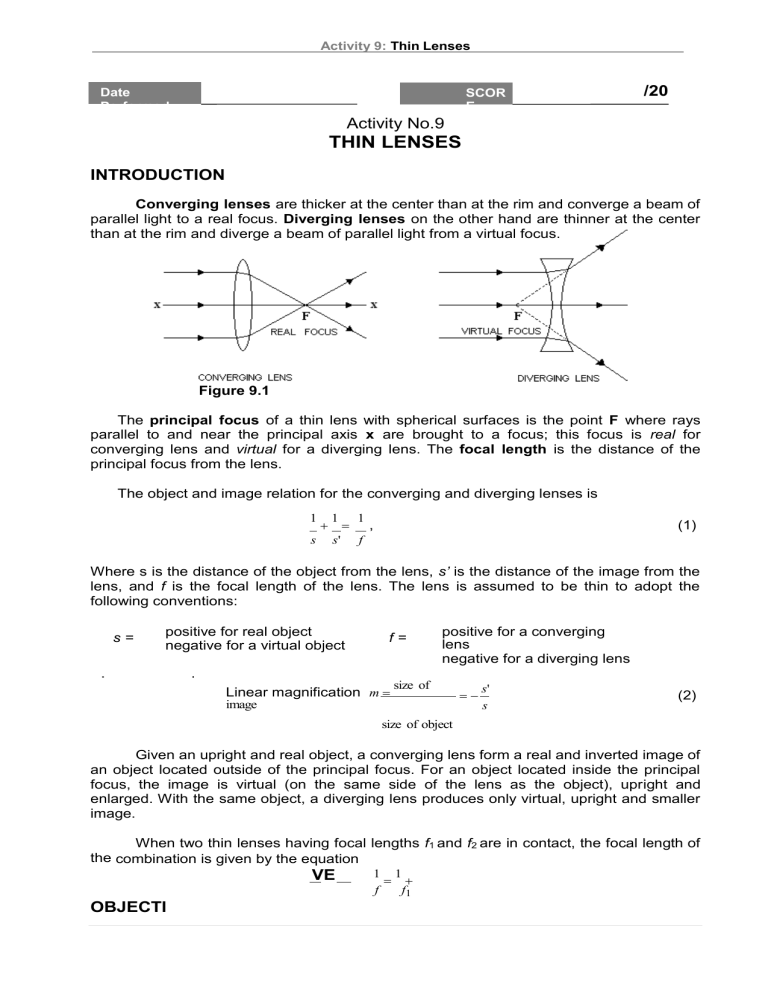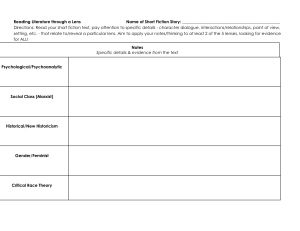
Activity 9: Thin Lenses Date Performed SCOR E /20 Activity No.9 THIN LENSES INTRODUCTION Converging lenses are thicker at the center than at the rim and converge a beam of parallel light to a real focus. Diverging lenses on the other hand are thinner at the center than at the rim and diverge a beam of parallel light from a virtual focus. Figure 9.1 The principal focus of a thin lens with spherical surfaces is the point F where rays parallel to and near the principal axis x are brought to a focus; this focus is real for converging lens and virtual for a diverging lens. The focal length is the distance of the principal focus from the lens. The object and image relation for the converging and diverging lenses is 1 1 1 , s s' f (1) Where s is the distance of the object from the lens, s’ is the distance of the image from the lens, and f is the focal length of the lens. The lens is assumed to be thin to adopt the following conventions: s= positive for real object negative for a virtual object . f= positive for a converging lens negative for a diverging lens . Linear magnification m size of image s' s (2) size of object Given an upright and real object, a converging lens form a real and inverted image of an object located outside of the principal focus. For an object located inside the principal focus, the image is virtual (on the same side of the lens as the object), upright and enlarged. With the same object, a diverging lens produces only virtual, upright and smaller image. When two thin lenses having focal lengths f1 and f2 are in contact, the focal length of the combination is given by the equation VE OBJECTI 1 1 f f1 Activity 9: Thin Lenses 1 . f2 (3) To measure the focal lengths of converging and diverging lenses. Activity 9: Thin Lenses APPARATUS Converging lens, diverging lens, lens holder, meter stick, colored chalk, rug, image screen, candle PROCEDURE A. Use of distant landscape 1. Fit a converging lens in a lens holder. Mount a white board image screen on a holder making sure it is in upright position. 2. Place the lens on one end of a table facing a window. The window serves as the object. Place the mounted screen on the end of the table with the lens in between. Adjust the position of the lens from the until an image of the window is sharply outlined on the screen. Measure the distance s's lens to the screen. The distance should be from the middle of the lens holder to the screen. s's = (1 point) Note: If the weather permits, use the sun as object and measure s's . (This is more accurate). Show why s's should be equal to the focal length of the lens. (2 points) B. Use of thin lens equation 1. Using colored chalk, draw a straight line across a table. 2. Place a lighted candle on one end of the drawn line. 3. Place the converging lens at a distance a little greater s's in Part A but less than 2 s's than from the candle. NOTE: The height of the candle should be such that its light is in line with the center of the lens. 4. Place the screen on the other end of the line. Adjust its position until an image of the candle light is sharply outlined on the screen. Measure the distance s of the candle light to the lens and the distance s’ of the screen to the lens. 5. Repeat Steps 3 and 4 for s satisfying the conditions as shown in the following table. Fill up Table 9.1 with the indicated data. Table 9.1. (10 points) Condition s for s s's s 2s's s 2s's 2s 's s 3s 's s 3s's s' y = 1/s x = 1/s’ xy x2 Activity 9: Thin Lenses 4 4 4 4 ∑ �� = ∑ �� = ∑ ���� = ∑ �2� = �=1 �=1 �=1 �=1 Activity 9: Thin Lenses Use linear regression to solve for the � ���������. Then solve for the focal length f using the relation � ��������� = 1⁄� .(3 points) Compare the result in procedure A to procedure B. (1 point)




